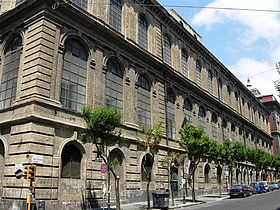
The Accademia di Belle Arti di Firenze is an instructional art academy in Florence, in Tuscany, in central Italy.

The Gallerie dell'Accademia is a museum gallery of pre-19th-century art in Venice, northern Italy. It is housed in the Scuola della Carità on the south bank of the Grand Canal, within the sestiere of Dorsoduro. It was originally the gallery of the Accademia di Belle Arti di Venezia, the art academy of Venice, from which it became independent in 1879, and for which the Ponte dell'Accademia and the Accademia boat landing station for the vaporetto water bus are named. The two institutions remained in the same building until 2004, when the art school moved to the Ospedale degli Incurabili.

The Accademia Carrara,, officially Accademia Carrara di Belle Arti di Bergamo, is an art gallery and an academy of fine arts in Bergamo, in Lombardy in northern Italy. The art gallery was established in about 1780 by Giacomo Carrara, a Bergamasco collector or conoscitore of the arts. The academy of fine arts was added to it in 1794. The school was recognised by the Ministero dell'Istruzione, dell'Università e della Ricerca, the Italian ministry of education, in 1988 and in 2023 merged with the Conservatorio Gaetano Donizetti to form the Politecnico delle Arti di Bergamo.

Renato Caccioppoli was an Italian mathematician, known for his contributions to mathematical analysis, including the theory of functions of several complex variables, functional analysis, measure theory.

The Accademia di Belle Arti di Bologna is a public tertiary academy of fine art in Bologna, in Emilia-Romagna in northern Italy. It has a campus in Cesena.

Domenico Morelli was an Italian painter, who mainly produced historical and religious works. Morelli was immensely influential in the arts of the second half of the 19th century, both as director of the Accademia di Belle Arti in Naples, but also because of his rebelliousness against institutions: traits that flourished into the passionate, often patriotic, Romantic and later Symbolist subjects of his canvases. Morelli was the teacher of Vincenzo Petrocelli and Ulisse Caputo.

The Accademia di Belle Arti di Venezia is a public tertiary academy of art in Venice, Italy.
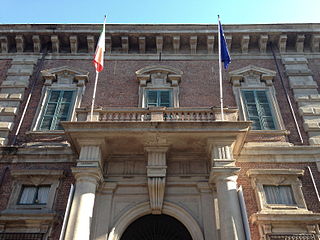
The Accademia di Belle Arti di Brera, also known as the Accademia di Brera or Brera Academy, is a state-run tertiary public academy of fine arts in Milan, Italy. It shares its history, and its main building, with the Pinacoteca di Brera, Milan's main public museum for art. In 2010 an agreement was signed to move the accademia to a former military barracks, the Caserma Magenta in via Mascheroni. In 2018 it was announced that Caserma Magenta was no longer a viable option, with the former railway yard in Via Farini now under consideration as a potential venue for the campus extension.

The Accademia delle Arti del Disegno is an academy of artists in Florence, in Italy. It was founded on 13 January 1563 by Cosimo I de' Medici, under the influence of Giorgio Vasari. It was initially known as the Accademia e Compagnia delle Arti del Disegno. It was made up of two parts: the company was a kind of guild for all working artists, while the academy was for more eminent artistic figures of the Medici court, and supervised artistic production in the Duchy of Florence.

Eduardo Dalbono was an Italian painter born in Naples.
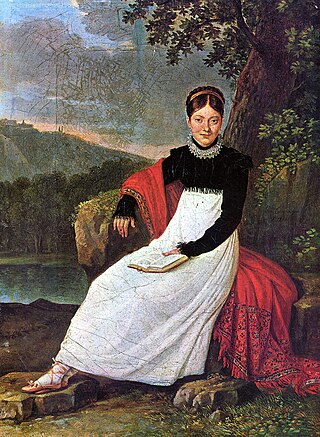
Giuseppe Cammarano was an Italian painter of frescoes and portraits.
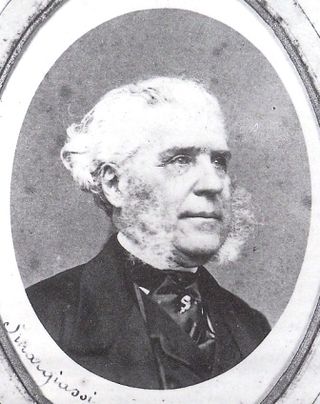
Gabriele Smargiassi was an Italian landscape painter and professor at the Academy of Fine Arts in Naples.

San Giovanni Battista delle Monache is a former Roman Catholic church located in Via Costantinopoli 106 in central Naples, region of Campania, Italy.
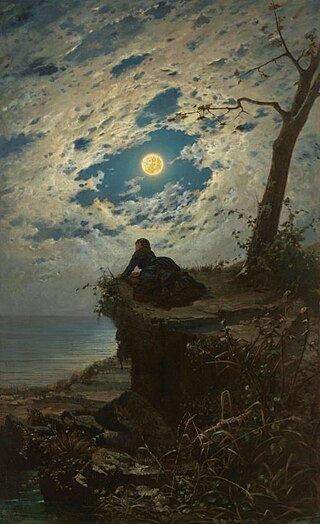
Alfonso Simonetti was an Italian painter of historical scenes, portraits and landscapes; best known for his works with moonlight and sunset effects.

The Accademia di Belle Arti di Roma is a public tertiary academy of art in Rome, Italy. It was founded in the sixteenth century, but the present institution dates from the time of the unification of Italy and the capture of Rome by the Kingdom of Italy in 1870.
Accademia often refers to:
The Accademia di Belle Arti di Bari is a public tertiary academy of art in Bari, in Puglia in southern Italy. It was established on 1 October 1970 and was formally approved by presidential decree on 15 March 1973.

The Accademia di Belle Arti di Carrara is a public tertiary academy of art in Carrara, in Tuscany, Italy. It was founded on 26 September 1769 by Maria Teresa Cybo-Malaspina, duchess of Massa and princess of Carrara; but its origins go back to 1757, when, on the advice of the sculptor Giovanni Domenico Olivieri, she founded the Accademia di San Ceccardo in which sculpture, architecture and painting were to be taught. To house it, she commissioned Filippo del Medico to design and build a new building ; in 1807, by order of Elisa Bonaparte Baciocchi, the accademia was moved the Palazzo del Principe. The school of architecture was at first under Filippo del Medico; Giovanni Antonio Cybei was head of the school of sculpture.

The Accademia di Belle Arti di Perugia is a private tertiary academy of art in Perugia, in Umbria in central Italy. It is not one of the 20 official Italian state academies of fine art, but is legally recognised by the Ministero dell'Istruzione, dell'Università e della Ricerca, the Italian ministry of education and research, which gives its full name as Accademia di Belle Arti Legalmente Riconosciuta di Perugia "Pietro Vannucci". The academy became an autonomous degree-awarding institution under law no. 508 dated 21 December 1999.

Francesco Paolo Palizzi, was an Italian painter; primarily known for landscapes.
